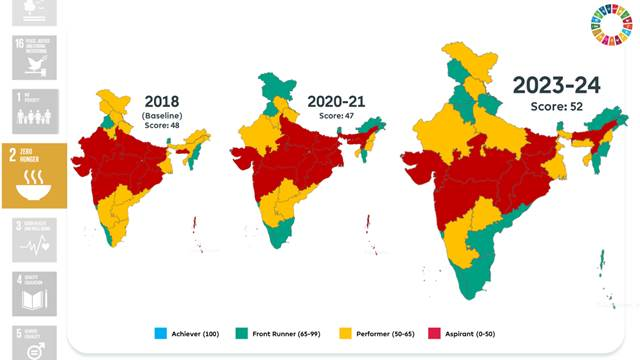Syllabus: GS2/Health
Context
- A new indicator on Minimum Dietary Diversity has been adopted by the United Nations Statistical Commission.
About
- FAO and UNICEF share custodianship of the new SDG indicator on Minimum Dietary Diversity (MDD).
- MDD indicator addresses a key gap in tracking progress toward SDG 2 (Zero Hunger) and the 2030 Agenda.
- The indicator was adopted by the United Nations Statistical Commission during its 56th session.
- MDD inclusion is a part of the 2025 Comprehensive Review of the SDG indicator framework.
| United Nations Statistical Commission – It was established in 1946. – It is the highest body of the global statistical system bringing together the Chief Statisticians from member states. – It is the highest decision making body for international statistical activities, responsible for setting of statistical standards and the development of concepts and methods, including their implementation. |
About Indicator on Minimum Dietary Diversity
- MDD-C & MDD-W: The new MDD indicator measures dietary diversity for children (MDD-C) and women of reproductive age (MDD-W).
- Indicator Definition: MDD-W is a simple yes/no measure based on whether women have consumed at least five out of 10 defined food groups in the past 24 hours.
- 10 Food Groups: Include grains, pulses, nuts, milk, meat, eggs, dark leafy vegetables, vitamin A-rich fruits/veggies, other vegetables, and other fruits.
- Importance of Diversity: Dietary diversity is essential for preventing malnutrition and supporting overall health, growth, and well-being.
- Focus on Quality: MDD emphasizes the variety of foods consumed, not just calorie intake, highlighting the importance of nutritious diets for health, growth, and well-being.
- FAO & UNICEF Roles: FAO oversees MDD-W, while UNICEF is responsible for MDD-C.
- Higher MDD Scores: A higher proportion of women meeting MDD thresholds indicates better vitamin and mineral intake.
Significance
- Quality of Diets: MDD adds a crucial measure of dietary quality to existing food security and nutrition indicators.
- Dietary Impact: MDD provides a tool for policy-making, program evaluation, and target-setting, focusing on vulnerable groups.
- Critical Step Forward: MDD helps track progress on achieving SDG 2.
- Future Impact: Elevates the importance of dietary diversity and food systems transformation, ensuring its place in post-SDG diet monitoring.
India’s Progress in SDG2

- Improvement in overall composite score of Goal 2 moving from Aspirant category in SDG India Index 3 (2020-21) to Performer category in the SDG India Index 4 (2023-24)
- 99.01% of beneficiaries covered under National Food Security Act (NFSA), 2013.
- Improvement in productivity of rice and wheat from 2995.21 kg/ha in 2018-19 to 3052.25 kg/ha in TE 2021-22.
- Increase in Gross Value Added (GVA) (constant prices) in agriculture per worker from ₹ 0.71 lakhs in 2018-19 to ₹ 0.86 lakhs in 2022-23.
| Sustainable Development Goals – The United Nations General Assembly, during its 70th Session in 2015, adopted the document titled “Transforming our World: The 2030 Agenda for Sustainable Development.” – This outlines 17 Sustainable Development Goals (SDGs) and 169 associated targets. – The SDGs, also known as the Global Goals, came into force from 2016. |
Source: DTE
Previous article
Disruptions in Parliament and State Assemblies
Next article
Starlink Satellite Internet